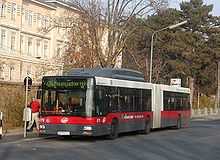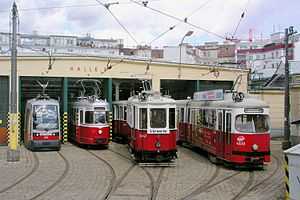Wiener Linien
|
4 generations of Wiener Linien trams at Breitensee Depot | |
| Overview | |
|---|---|
| Locale | Vienna, Austria |
| Transit type | Bus, tram, and underground |
| Number of lines | 46 day bus, 20 night bus, 28 tram, 5 underground |
| Number of stations |
1,128 tram 90 underground |
| Annual ridership |
839 million (2010)[1] 534,400,000 underground (2010) 189,900,000 tram (2010) 114,400,000 bus (2010) |
| Chief executive | Günter Steinbauer (CEO) |
| Headquarters | Erdbergstraße 202, 1030 Wien |
| Website | www.wienerlinien.at |
| Operation | |
| Began operation | 1999, previously Wiener Stadtwerke – Verkehrsbetriebe |
| Operator(s) | Wiener Stadtwerke Holding AG |
| Number of vehicles | 496 buses, 772 tramcars, 848 underground carriages[1] |
| Technical | |
| System length |
621.5 km (386.2 mi) bus 214.8 km (133.5 mi) tram 74.2 km (46.1 mi) underground[1] |
Wiener Linien (Vienna Lines) are the company running the largest part of the public transit network in the city of Vienna, Austria. They are part of the city corporation Wiener Stadtwerke Holding AG.
Governing structure and statistics
Until decentralisation on 11 June 1999, Wiener Linien was Wiener Stadtwerke – Verkehrsbetriebe, a directly administered subsidiary of the Vienna city government as they had been for over a hundred years. They are still under city control as part of the responsibilities of the City Administrator for Finance and Economics, currently Renate Brauner.
As of 2009, Wiener Linien employ approximately 8,000 people and serve approximately 812 million passengers. Ridership numbers have climbed since the 1970s and now exceeds those of 2005 by approximately 60 million. The number of annual season ticket holders has risen to a new record of 334,577, of whom approximately one third are seniors. 24% of all passengers are schoolchildren. Sales rose slightly in 2004 to €345.2. According to surveys, 36% of all journeys in Vienna are completed using public transport, which puts the city in first place in Europe.
Passengers are represented by a Passenger Advisory Council and can make suggestions for improvements. Council members serve four-year terms.[2]
Transit network (as of 2007)

Wiener Linien operate bus and tram (Straßenbahn) surface routes, and partly underground, partly overground metro or underground train lines (Vienna U-Bahn).
The U-Bahn network is being steadily expanded, and to a lesser extent the bus routes, especially in outlying areas of the city. U-Bahn ridership is likewise growing strongly, but in contrast tram ridership is slightly lower and there has been a reduction in tram mileage in recent years (from 231.4 km (143.8 mi) in 2004 to 227.3 km (141.2 mi) in 2007).
- 5 U-Bahn lines with 65.1 km (40.5 mi) gross length (65.7 km (40.8 mi) operational length, 69.3 km (43.1 mi) built length, 201.3 km (125.1 mi) of rail) and 476.7 million passengers (approximately 50 million more than in 2004)
- 28 tram lines with 227.3 km (141.2 mi) gross length (179 km (111 mi) operational length, 181 km (112 mi) built length) and 200.4 million passengers (approximately 7 million fewer than in 2004)
- 43 daytime bus routes and 23 night bus routes with a total of 669.1 km (415.8 mi) gross length and 116 million passengers (exactly 5 million more than in 2004)
The system is supplemented by 26 bus routes operated by subcontractors who also operate their own routes in and around Vienna. In addition there are 7 routes of Demand responsive transport. Vienna Linien services also connect to mainline ÖBB trains.
Most daytime services run between 5:00 am and 0:30 am. During rush hours, many routes run at intervals of two to five minutes; during evening hours, the U-Bahn runs at 7 and a half minute intervals and trams and buses every ten or 15 minutes. Between 0:30 and 5:00 am, night bus routes run every 15 to 30 minutes. Following a February 2010 plebiscite, nighttime U-Bahn service on weekends at 15-minute intervals is to be instituted in September 2010.[3][4]
Wiener Linien fares are integrated into the VOR (Verkehrsverbund Ost-Region, East Region Transportation Association); their routes all lie within its core zone (Zone 100). Schoolchildren, students, the unemployed, and pensioners are served at considerably reduced prices.
U-Bahn
The Vienna U-Bahn has existed under this name since 1976, when the stretch of the 1898–1901 Wiener Stadtbahn (Vienna Metropolitan Railway) between Heiligenstadt and Friedensbrücke stations was experimentally adapted and placed in operation as Line U4. The construction of a metro in Vienna had been preceded by decades of political debate, since the Social Democratic majority in Vienna had initially preferred other modes of transit. The first stretch of newly constructed U-Bahn rail was placed in operation in 1978 (U1 from Reumannplatz to Karlsplatz). The Vienna U-Bahn system currently consists of five lines, is 69.5 km (43.2 mi) long and has 84 stations:
- U1 Reumannplatz–Leopoldau (extension southwards from Reumannplatz to Oberlaa under construction)
- U2 Seestadt–Karlsplatz (expansion eastwards from Stadion to Aspernstrasse opened in October 2010; further extension from Aspernstrasse to Seestadt opened in October 2013)[5]
- U3 Ottakring–Simmering
- U4 Hütteldorf–Heiligenstadt (westwards expansion westwards from Hütteldorf under discussion)
- U6 Siebenhirten-Floridsdorf (expansion from Floridsdorf northwards under discussion)
Trams
The Wiener Straßenbahn (Vienna tramway) has existed since 1865, when the first horsedrawn tram went into service; the first line was electrified in 1897. Originally operated by private transport firms, the tramway was purchased by the city government around 1900 and in the years that followed massively expanded under the name Gemeinde Wien - Städtische Straßenbahnen (Municipality of Vienna - City Tramways). Electrified at the city's expense, the trams were integrated into the transport network in 1925. Until construction of the U-Bahn, the trams were the primary mode of public transport in Vienna.
After 1945, numerous tram lines were abandoned because of increasing use of private cars or converted to bus routes because of economic unviability. Beginning in 1978, in the course of construction of the U-Bahn, tram routes parallelling U-Bahn routes were introduced. Nonetheless, the tram system in Vienna remains one of the most extensive in the world. 28 routes currently operate on 227.3 km (141.2 mi) of rail. Further cutbacks are expected in the next few years as the U-Bahn continues to expand; however, extensions and new lines are also planned, above all in the 21st and 22nd districts.
Bus
The Municipality of Vienna has operated bus lines since the 1920s; they increased in importance after suburban development increased demand for transport connections and after many tram lines in densely built-up areas were replaced by bus service.
Currently approximately 500 buses are in operation on 43 daytime and 23 nighttime routes along approximately 360 km (220 mi) of streets, carrying approximately 120 million passengers a year. Vienna Linien bus routes are designated with A (for Autobus) to distinguish them at a glance from tram routes. Additional bus routes within Zone 100 of the Verkehrsverbund Ost-Region, most of which are operated by other companies, such as Dr. Richard, and for which VOR tickets are also valid, are designated with B to distinguish them.
Criticism
In 2005, Vienna Linien received the negative Big Brother Award in the People's Choice category because of camera surveillance.[6][7]
References
- ↑ 1.0 1.1 1.2 Ein Blick auf die Leistung - Jahresbericht 2010 May 2012 (pdf, German), p. 4.
- ↑ Unternehmen - Fahrgastbeirat, Wiener Linien 2009 (German), retrieved 22 June 2010.
- ↑ "Nacht-U-Bahn kommt in Viertelstunden-Takt" (Nighttime underground coming at 15-minute rate), 24 Stunden für Wien. Das Kundenmagazin der Wiener Stadtwerke 205, March 2010 (pdf, German), p. 3.
- ↑ Webseite der Wiener Linien: Die 24-Stunden-U-Bahn im Jahr 2010 in 37 Nächten unterwegs (24-hour underground in operation for 2010 in 37 days - German), Wiener Linien, retrieved 22 June 2010.
- ↑ "Railway Gazette: Wiener Linien opens U2 extension". Retrieved 2010-10-16.
- ↑ "Big Brother Awards Austria (nicht nur) für österreichische Datenkraken" (Big Brother Awards Austria (not just) for Data-Krakens), Heise online 26 October 2005, retrieved 22 June 2010.
- ↑ "Preisträger" (Prizewinners), Big Brother Awards Austria 2005 (German), retrieved 22 June 2010.
External links
| Wikimedia Commons has media related to Wiener Linien. |
- Official website
- Tram Travels: Wiener Linien
- Wiener Linien Fanpage: news, forum, photo gallery (German)
- A tour with tram 1 in Vienna Austria (Video tour of the Vienna Ring Road)
| ||||||||
Coordinates: 48°11′23″N 16°24′52″E / 48.18972°N 16.41444°E
